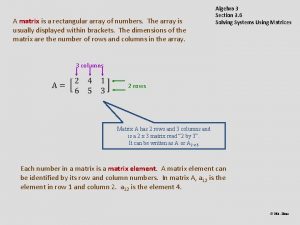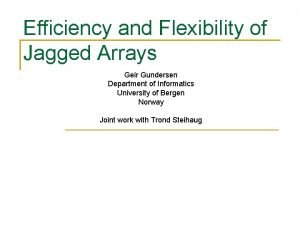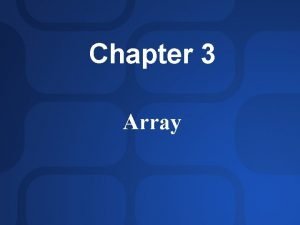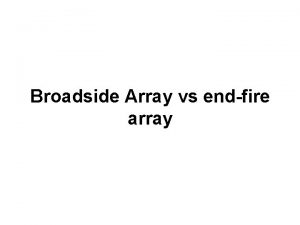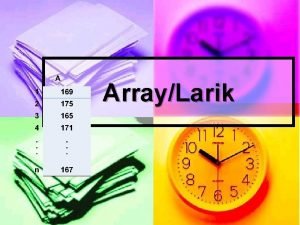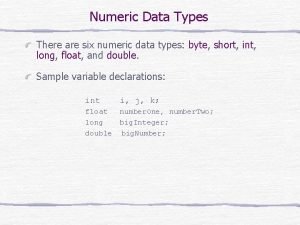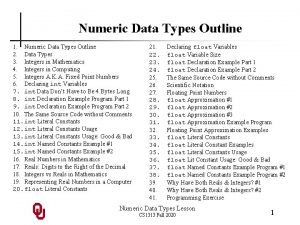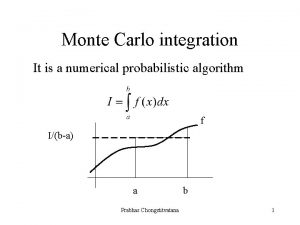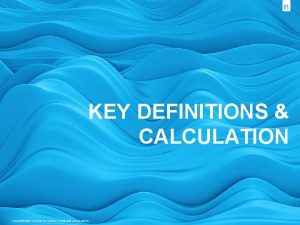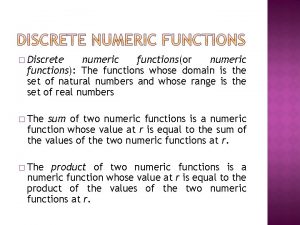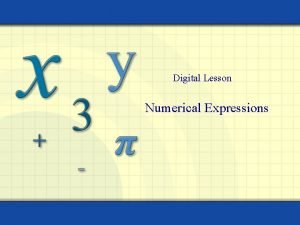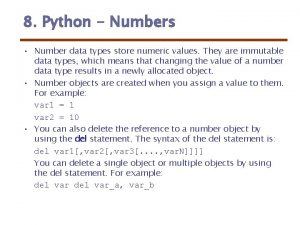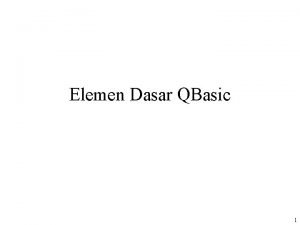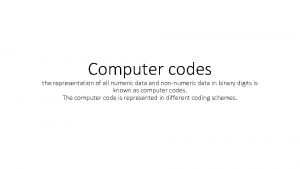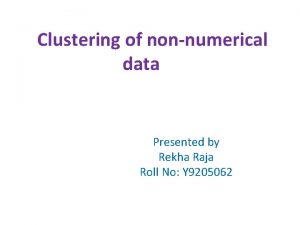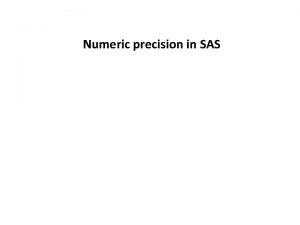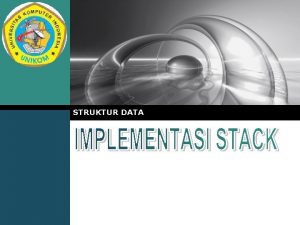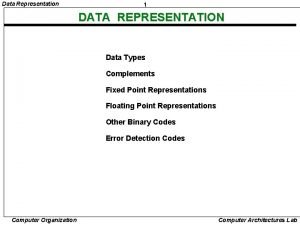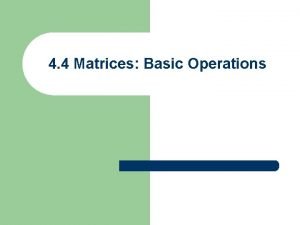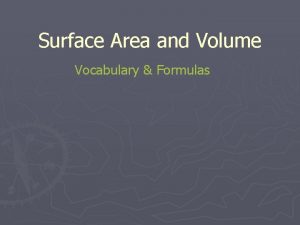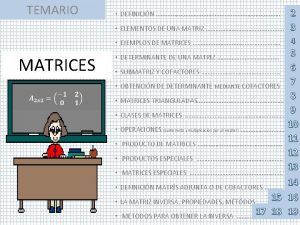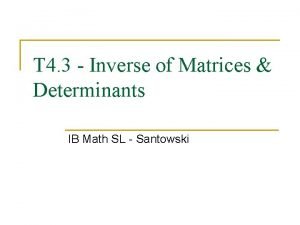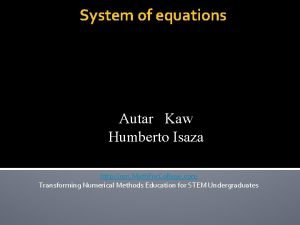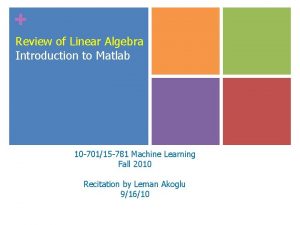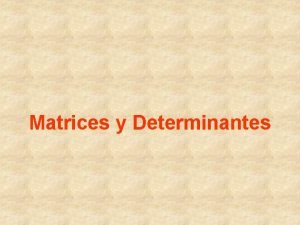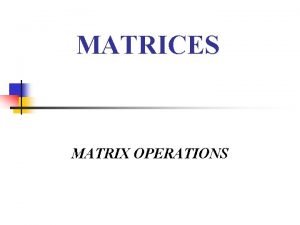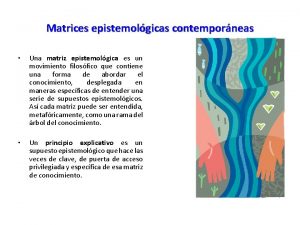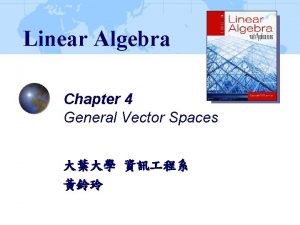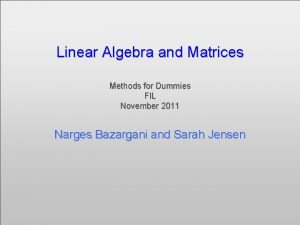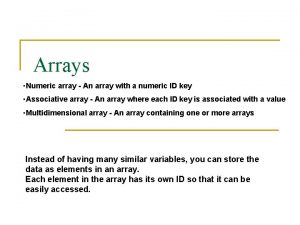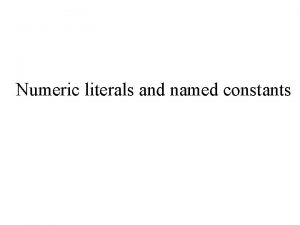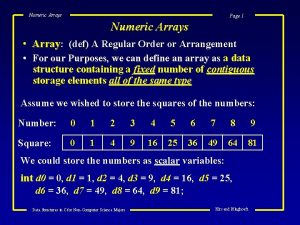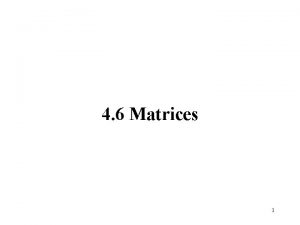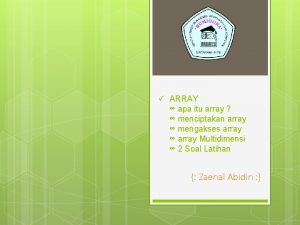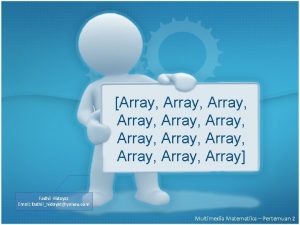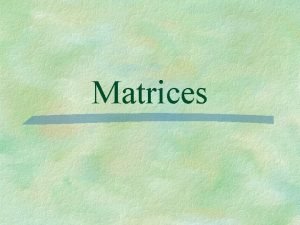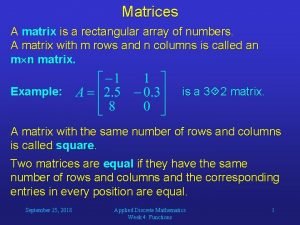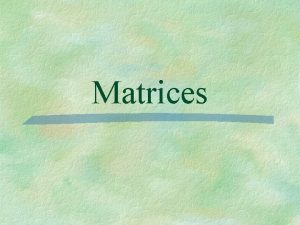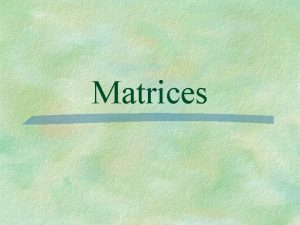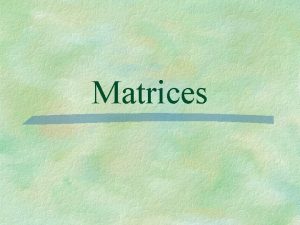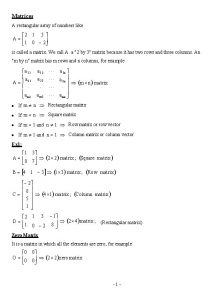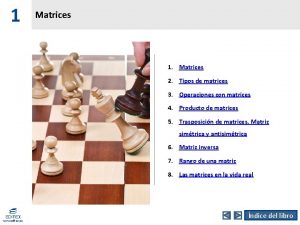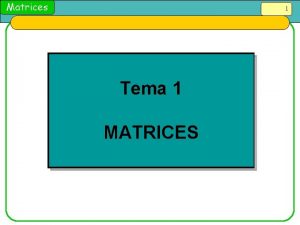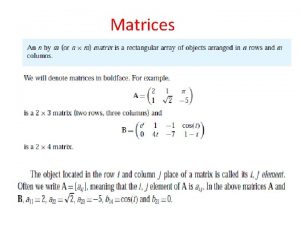MATRICES DEFINITION A rectangular array of numeric or




















































- Slides: 52

MATRICES

DEFINITION • A rectangular array of numeric or algebraic quantities subject to mathematical operations. • Something resembling such an array, as in the regular formation of elements into columns and rows.

DEFINITION •

EQUAL MATRICES •

YOU TRY… •

ADDING AND SUBTRACTING MATRICES • In order to add or subtract matrices, the must have the same order.

ADDING MATRICES •

SUBTRACTING MATRICES •

SOLVING MATRIX EQUATIONS FOR X •

INVERSES

IDENTITY ELEMENT •

DETERMINANT •


MULTIPLICATION

CHECK FIRST • Use the order of the matrix to check whether or not we can multiply them: • The number columns of the first matrix must match the number of rows in the second matrix. • The number of rows in the first matrix paired with the number of columns in the second matrix gives us the dimensions of the product matrix.

They must match. Dimensions: 2 x 3 The dimensions of your answer. 3 x 2

EXAMPLES •

HOW DO WE DO IT? •

WHAT’S THE PATTERN? •

EXAMPLES

Examples: 2(3) + -1(5) 2(-9) + -1(7) 2(2) + -1(-6) 3(3) + 4(5) 3(-9) + 4(7) 3(2) + 4(-6)

Dimensions: 2 x 3 2 x 2 *They don’t match so can’t be multiplied together. *

*Answer should be a 2 x 2 0(4) + (-1)(-2) 0(-3) + (-1)(5) 1(4) + 0(-2) 1(-3) +0(5)

SYSTEMS OF EQUATIONS APPLICATIONS

STEPS TO CREATING AN EQUATION FROM CONTEXT: 1. Read the problem statement 2. Identify the known quantities 3. Identify the unknown variables 4. Create an equation using the known quantities and the variables you found. Keep in mind… q In systems of equations, you will have 2 or 3 equations (hence the “system” part). Therefore, you will have to decide which quantities and variables belong together.

EXAMPLE • The admission fee at a small fair is $1. 50 for children and $4. 00 for adults. On a certain day, 2200 people enter the fair and $5, 050 is collected. How many children and how many adults attended?

EXAMPLE 2 • Two small pitchers and one large pitcher can hold 8 cups of water. One large pitcher minus one small pitcher constitutes 2 cups of water. How many cups of water can each pitcher hold?

EXAMPLE 3 • A test has twenty questions worth 100 points. The test consists of True/False questions worth 3 points each and multiple choice questions worth 11 points each. How many multiple choice questions are on the test?

SOLVING SYSTEMS USING INVERSE MATRICE S

Solve the system using inverse matrices 3 x + 2 y = 7 4 x - 5 y = 11 You can use the inverse of the coefficient matrix to find the solution. Set up a matrix equation to find the solution. The formula to find the solution is:

Solve the system using inverse matrices 2 x - 4 y = 9 3 x - 2 y = 1 Set up a matrix equation to find the solution. The formula to find the solution is:

Solve the system using inverse matrices x + 4 y = 8 2 x - 2 y = -6 Set up a matrix equation to find the solution. The formula to find the solution is:

Solve the system using inverse matrices The formula to find the solution is: Set up a matrix equation to find the solution.

VERTEX-EDGE GRAPHS

WHAT IS A VERTEX-EDGE GRAPH? • A collection of points, some of which are joined by line segments or curves • Examples:

VERTEX • A point on the graph.

EDGE • A line segment or curve connecting the vertices of a graph.

IN THE REAL-WORLD • Vertices may represent things such as people or places. • Edges may represent connections such as roads or relationships. What are the edges, and what do they represent? What about the vertices?

COMPLETE GRAPH • A graph in which every vertex is adjacent to every other vertex. • Which of these is complete? A B

DIGRAPH • A directed vertex edge graph

DEGREE OF THE VERTEX • The number of edges that enter a vertex. What is the degree of vertex A? 2 What is the degree of vertex C? 4

REAL WORLD EXAMPLE • The vertex edge graph below represents five people: Bob (B), Dustin (D), Mike (M), Sue (S) and Tammy (T). • An edge connecting two vertices indicates that those two people have a class together.

WHO HAS A CLASS WITH MIKE? Tammy & Sue

WHO DOES NOT HAVE A CLASS WITH BOB? Tammy & Mike

USING MATRICES TO REPRESENT A VERTEX-EDGE GRAPH • We can use an adjacency matrix to represent the vertex-edge graph. • Step 1: Create a matrix listing all vertices in the row and column. • Step 2: Fill in the matrix listing the number of relationships between the two points. • If they share an edge, there will be a “ 1” • If there is no relationship, there will be a “ 0”

CREATE A MATRIX USING THE FOLLOWING VERTEX-EDGE GRAPH:

CREATE A MATRIX USING THE FOLLOWING VERTEX-EDGE GRAPH: R S V T U

DRAWING A VERTEX-EDGE GRAPH • Use the following matrix to create the vertexedge graph that corresponds.

DRAWING A VERTEX-EDGE GRAPH • Use the following matrix to create the vertexedge graph that corresponds.

EXTENDED RELATIONSHIPS • A railway serves four cities: Harrisburg, Baltimore, Philadelphia and Atlantic City. Trains travel between Harrisburg and Baltimore, Harrisburg and Philadelphia, and Philadelphia and Atlantic City. • Draw a vertex edge graph and it’s adjacency matrix to represent this situation.

RAILWAY CONTINUED… •

SUMMARY 3 -2 -1 • On a separate sheet of paper to turn in, list: • 3 vocabulary words you have learned and their relationship to the vertex-edge graph • 2 reasons to use a vertex-edge graph • 1 real-world example of a vertex-edge graph
 A rectangular array of numbers.
A rectangular array of numbers. Define transpose of a matrix
Define transpose of a matrix Lga vs pga
Lga vs pga Suatu array a dideklarasikan sbb float a 5 5 5
Suatu array a dideklarasikan sbb float a 5 5 5 Jagged array vs multidimensional array
Jagged array vs multidimensional array Associative array vs indexed array
Associative array vs indexed array Broadside array and endfire array difference
Broadside array and endfire array difference Larik+adalah
Larik+adalah Sparse array adalah
Sparse array adalah Contoh program matriks array 2 dimensi python
Contoh program matriks array 2 dimensi python Photovoltaic array maximum power point tracking array
Photovoltaic array maximum power point tracking array Isced 2011
Isced 2011 Geographic filing system example
Geographic filing system example Numeric data types in java
Numeric data types in java Numeric outline
Numeric outline Numeric integral
Numeric integral Numeric distribution vs weighted distribution nielsen
Numeric distribution vs weighted distribution nielsen Discrete numeric functions
Discrete numeric functions Numeric expression example
Numeric expression example Variabel numerik dan kategorik
Variabel numerik dan kategorik Numeric data types in python
Numeric data types in python Numeric constant in qbasic
Numeric constant in qbasic Numeric indicator
Numeric indicator Representation codes
Representation codes Nprs scale
Nprs scale Ascii classification
Ascii classification Clustering non numeric data
Clustering non numeric data Proper keyboarding technique
Proper keyboarding technique Sas numeric precision
Sas numeric precision Notasi infix
Notasi infix Output devices advantages and disadvantages
Output devices advantages and disadvantages Types of data representation
Types of data representation Sqlite numeric type
Sqlite numeric type Straight numeric filing
Straight numeric filing Quotient of powers property
Quotient of powers property Subtraction of matrices definition
Subtraction of matrices definition Surface are definition
Surface are definition Testul raven raspunsuri corecte
Testul raven raspunsuri corecte Matrices diagonal
Matrices diagonal Can matrices be divided
Can matrices be divided Can matrices be divided
Can matrices be divided Linear independence of vectors
Linear independence of vectors Woodcock johnson reading
Woodcock johnson reading Stan grof coex
Stan grof coex Inversa matriz 2x2
Inversa matriz 2x2 Ejemplos de igualdad de matrices
Ejemplos de igualdad de matrices Matrix of equations
Matrix of equations Ivory no.1 retainer uses
Ivory no.1 retainer uses Operations with matrices
Operations with matrices Matriz epistemologica
Matriz epistemologica Vector space of matrices
Vector space of matrices Matrix for dummies
Matrix for dummies 3 by 3 matrix
3 by 3 matrix
